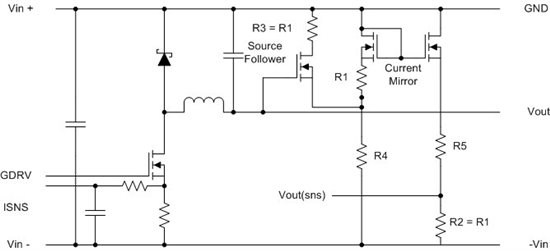Vin = -7.7V (negative voltage)
Vout= adjustable through external controller between -5.0V and -3.0V (negative output)
Current=7.4A
Do you have a suggestion on what IC and topology I should use?
This thread has been locked.
If you have a related question, please click the "Ask a related question" button in the top right corner. The newly created question will be automatically linked to this question.
Vin = -7.7V (negative voltage)
Vout= adjustable through external controller between -5.0V and -3.0V (negative output)
Current=7.4A
Do you have a suggestion on what IC and topology I should use?
Angela,
You can use a TPS40210 to build an "high-side buck" converter, you'll just need a circuit to reflect the output voltage to the negative input rail (which will be the GND of the TPS40210 controller)
This looks like this:

R4 is sized to such that it needs 2x th current of R1 when R1 has GND - VOUT across it and the current mirror MOSFET drops its threshold voltage. This provides that the voltage drop across R3 is the same as the voltage drop across R1 and both the source follower and current mirror have the same Vds to provide better matching.
R5 would then be 2x R4 so current mirror MOSFETs have the same Vds, but this could saturate the current mirror, so R5 should be sized to 1.5 - 1.8x R4 to ensure some headroom for the output of the current mirror.
This circuit has the same performance characteristics and transfer function as a standard non-synchronous BUCK, but Vout is measured as (GND - VOUT)
Angela,
There is an error in the above circuit's current mirror. The base topology is correct, but the circuit to reflect the voltage to the low-side rail is not. I will correct this in a new post shortly.
Here is the corrected circuit

Since these are external MOSFETs and the two MOSFETs of the current mirror will have slightly different Vds voltages, they wont have perfect matching, so the 5V precision will be a little wider than normal and R3 should be sized to to keep the Vds of the two FETs of the current mirror as close as possible without dropping below their threshold voltage. Using higher voltage small signal MOSFETs (such as a 60 - 100V MOSFET) will decrease this effect. A Cascode would also help, but would improve the accuracy, but involves 4 additional MOSFETs.
An alternative would be to use a differential amplifier across Vout to reflect Vout to -Vin.

A few more components, but this offers much better accuracy.
Angela,
This is a non-synchronous appliction requiring an external MOSFET and Diode. With a 5V output voltage and 7.7V input voltage, which proper sizing of the components (as you would with a 7.7V to 5V non-synchronous BUCK converter) it should be ok. The TPS40210's gate drive is only 500mA gate drive, but if you select a low-gate charge MOSFET like one of TI's NexFETs, it should provide fast switching and reasonably high efficiency.
The CSD16411Q3 for example is a 3mm x 3mm 25V MOSFET with an Rdson of 12mOhms (4.5V gate drive) and a switching charge of about 3.7nC, for a switch time of only 7ns with the TPS40210's 500mA gate drive. This would give you about 430mW power dissipation at 7.7V to 5V @ 7.4A (a 37W output power)
The power diode will carry about 2.6A of average forward current in 7.4A pulses for about 1W of power dissipation.
Pete,
Can you give me your email address. I have some questions I need to send to you off public domain.